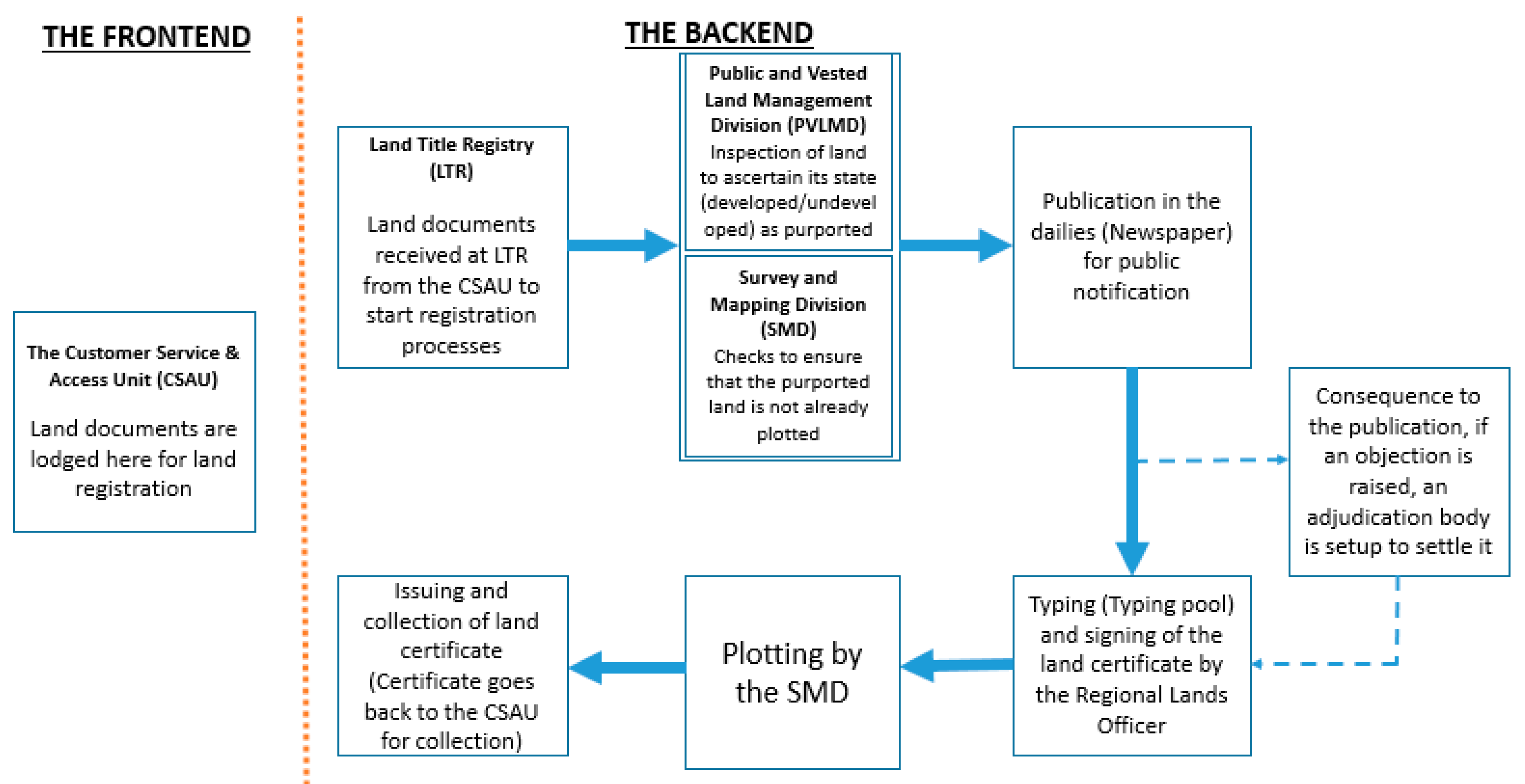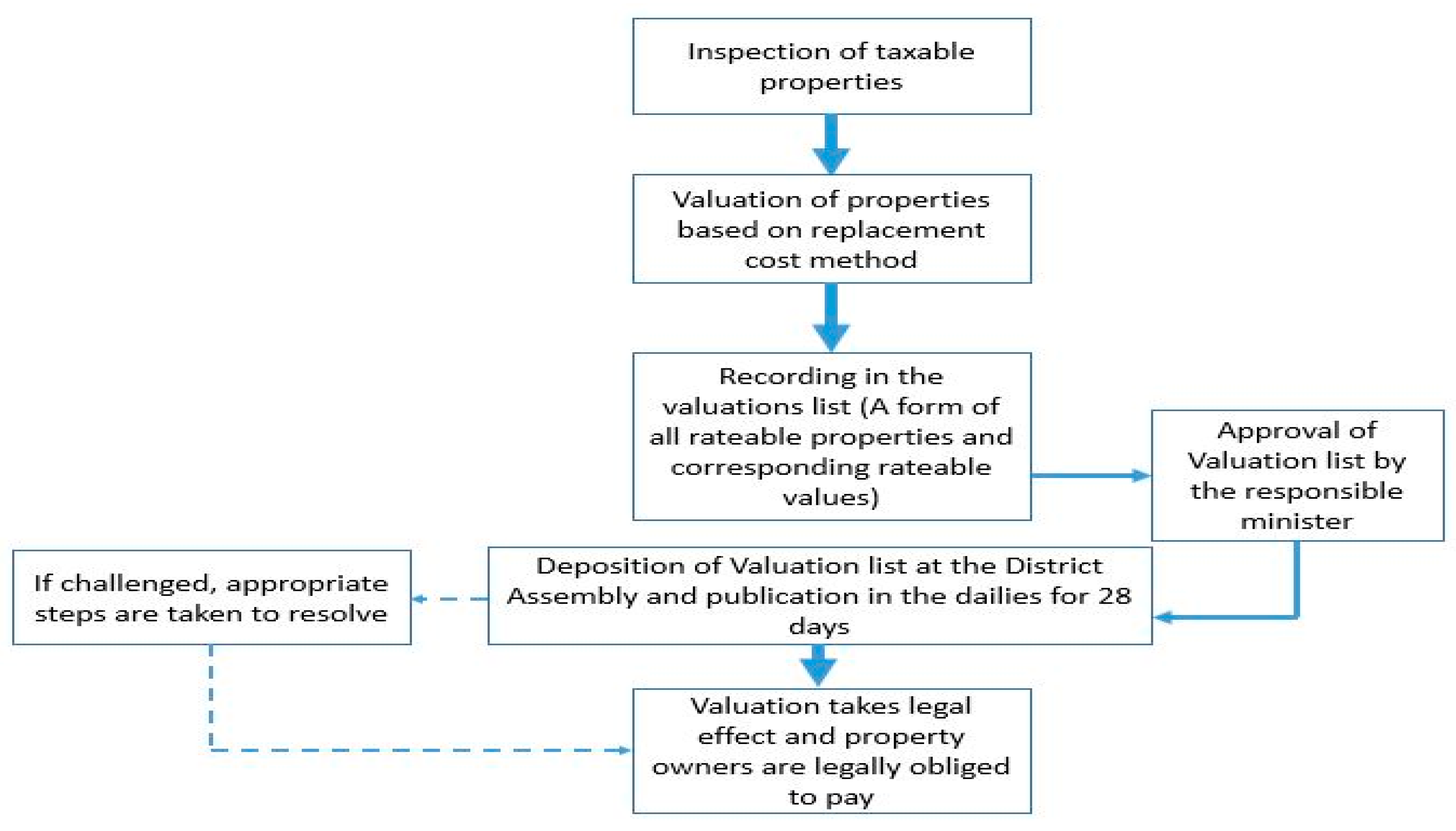Transparency of Land Administration and the Role of Blockchain Technology, a Four-Dimensional Framework Analysis from the Ghanaian Land Perspective
Abstract
1. Introduction
‘Pro-poor support: rule of law is equal to all, and citizen has protected rights, Public confidence: greater public confidence, Economic growth: security of the land tenure and regulated transaction cost and taxation, Protection of state assets: legitimate use of state land for social and economic concessions, More effective and efficient public administration of land: formal market and reliable system, more revenue sharing for public services, Conflict prevention and resolution: equity, justice, and social stability’[9] (p. 13)
- To identify the essential elements and relations between blockchain technology and the transparency of land administration in the existing literature;
- To assess the potential of blockchain technology to improve the transparency of land administration functions—based on the Ghanaian land administration context.
2. Materials and Methods
2.1. Research Approach and Boundaries
2.2. Data Sources and Research Methods
3. Results
3.1. Theoretical Basis of Blockchain Technology and Its Operation
- A node/stakeholder with an account signs digitally and initiates the transaction;
- A timestamp is added to prove the time of transaction creation;
- Transaction is broadcasted by decentralization to all other nodes on the network;
- The transaction is mined (‘’which involves validation of a set of transactions (block) in the network by means of showing the computational proof of the work done’’) [24] (p. 20), by one of the nodes. After this, it is verified and validated as authentic, or declined if it is found otherwise by the majority of the nodes based on a consensus mechanism;
- The validated transaction is then recorded in a new block and hashed to the previous block to form the chain of blocks as is shown after Figure 1.
3.2. Summary Overview of Land Administration Processes in Ghana
3.2.1. Land Tenure Processes
3.2.2. Land Valuation Processes
3.2.3. Land Use Planning and Land Development Processes
4. Discussion
Transparency Issues of Land Administration Processes in Ghana and the Role of Blockchain Technology
- Openness: through the decentralized broadcasting of transactions to all the integrated stakeholders, every decision or action can be known to all and no action can be hidden. Thus, although the different stages of the registration process involve different stakeholders, every stakeholder is aware of each stage, as well as, what, how, and when work is done on the transaction which allows for openness.
- Availability and access to land information: information imbalance obstructs accessibility to credible land data which breeds ignorance and permits fraudulent deals as some stakeholders become oblivious of other happenings in the transaction. The decentralized broadcasting of transactions and all associated information across the stakeholders, coupled with the verification and validation, as well as the hashing of new transaction blocks to historical blocks allows for easy accessibility to all relevant information (both current and historical) on land ownership, parcel, and rights, by all stakeholders at all times. This will help eliminate information asymmetry and its associated challenges of bribery and corruption.
- Participatory processes: the verification and validation through the consensus mechanism foster maximum participation in the entire registration processes from all stakeholders, since this allows the majority stakeholders to be part of transactions’ decision making every time. The consensus mechanism takes place at every stage of the registration process until it is completed. Moreover, the broadcasting of process stages to all stakeholders automatically induces participation in the processes either actively or inactively. This is because everyone is aware of every happening and can give their contributions accordingly as and when necessary. That is, stakeholders are always privy to and aware of all the happenings and processes. This makes every stakeholder part of the transaction and registration processes in the participatory sense.
5. Conclusions
Author Contributions
Funding
Acknowledgments
Conflicts of Interest
References
- Vos, J.; Lemmen, C.; Beentjes, B. Blockchain-Based Land Administration Feasible, Illusory or a Panacea? In Proceedings of the Responsible Land Governance: Towards an Evidence Based Approach, Washington, DC, USA, 20–24 March 2017. [Google Scholar] [CrossRef]
- Lemmen, C.; Vos, J.; Beentjes, B. Ongoing Development of Land Administration Standards: Blockchain in Transaction Management. Eur. Prop. Law J. 2017, 4, 478–502. [Google Scholar] [CrossRef]
- Dawidowicz, A.; Źróbek, R. Land Administration System for Sustainable Development—Case Study of Poland. Real Estate Manag. Valuat. 2017, 4, 112–122. [Google Scholar] [CrossRef]
- Bagdai, N.; van der Molen, P.; Tuladhar, A. Does uncertainty exist where transparency is missing? Land privatisation in Mongolia. Land Use Policy 2012, 4, 798–804. [Google Scholar] [CrossRef]
- Williamson, I.P.; Grant, D.M. United Nations-FIG Bathurst Declaration on Land Administration for Sustainable Development: Development and Impact. In Proceedings of the XXII FIG International Congress, Washington, DC, USA, 19–26 April 2002. [Google Scholar]
- Enemark, S. Building land information policies. In Proceedings of the Special Forum on Building Land Information Policies in the Americas, Aguascalientes, Mexico, 26 October 2004; Volume 26, p. 2004. [Google Scholar]
- Locke, A.; Henley, G. The Possible Shape of a Land Transparency Initiative: Lessons from Other Transparency Initiatives. 2013. Available online: http://search.ebscohost.com/login.aspx?direct=true&db=lah&AN=20133405582&site=ehost-live%5Cnhttp://www.odi.org.uk/sites/odi.org.uk/files/odi-assets/publications-opinion-files/8599.pdf%5Cnemail:a.locke@odi.org.uk (accessed on 1 February 2020).
- UN-Habitat. Tenure Responsive Land Use Planning: A Guide for Country Level Implementation. 2016. Available online: www.unhabitat.org (accessed on 18 April 2020).
- Bell, K.C.; Bell, K.C. Good Governance in Land Administration; World Bank: Washington, DC, USA, 2007. [Google Scholar]
- Phuong, T.H. Enhancing Transparency in Land Transaction Process by Reference Architecture for Workflow Management System. In Proceedings of the PACIS, Ho Chi Minh City, Vietnam, 11–15 July 2012; p. 69. [Google Scholar]
- Anand, A.; McKibbin, M.; Pichel, F. Colored Coins: Bitcoin, Blockchain, and Land Administration. In Annual World Bank Conference on Land and Poverty. 2015. Available online: https://www.ubitquity.io/home/resources/worldbank_land_paper_ubitquity_march_2016.pdf (accessed on 8 January 2020).
- Bagdai, N.; van der Veen, A.; van der Molen, I.P.; Tuladhar, A. Transparency as a Solution for Uncertainty in Land Privatization—A Pilot Study for Mongolia. In Proceedings of the Surveyors Key Role in Accelerated Development, Eilat, Israel, 3–8 May 2009. [Google Scholar]
- Jaitner, A.; Caldeira, R.; Koynova, S. Transparency International-Land Corruption in Africa-Finding Evidence, Triggering Change. In Proceedings of the Annual World Bank Conference on Land and Poverty, Washington, DC, USA, 20 March 2017. [Google Scholar]
- Spielman, A. Blockchain: Digitally Rebuilding the Real Estate Industry. Ph.D. Thesis, Massachusetts Institute of Technology, Cambridge, MA, USA, 2016. [Google Scholar]
- Lemieux, V.L. Evaluating the Use of Blockchain in Land Transactions: An Archival Science Perspective. Eur. Prop. Law J. 2017, 4, 392–440. [Google Scholar] [CrossRef]
- Rizal Batubara, F.; Ubacht, J.; Janssen, M. Unraveling Transparency and Accountability in Blockchain. In Proceedings of the 20th Annual International Conference on Digital Government Research, Dubai, UAE, 18–20 June 2019; pp. 204–213. [Google Scholar] [CrossRef]
- Müller, H.; Seifert, M. Blockchain, a Feasible Technology for Land Administration? In Proceedings of the FIG Working Week, Hanoi, Vietnam, 22–24 April 2019.
- Singh, H.; Gupta, H.; Singh, A.; Litoria, P.K. Applications of Blockchain for Land Record Management. In Proceedings of the National Conference on Role of Geospatial Technologies to Bridge the Rural and Uraban Divide, Ludhiana, India, 22–23 February 2018. [Google Scholar]
- Eder, G. Digital Transformation: Blockchain and Land Titles. In Proceedings of the OECD Global Anti-Corruption & Integrity Forum, Paris, France, 20–21 March 2019. [Google Scholar]
- Shang, Q.; Price, A. A Blockchain-Based Land Titling Project in the Republic of Georgia: Rebuilding Public Trust and Lessons for Future Pilot Projects. Innov. Technol. Gov. Glob. 2019, 4, 72–78. [Google Scholar] [CrossRef]
- Bal, M. Securing Property Rights in India Through Distributed Ledger Technology; Observer Research Foundation: New Delhi, India, 2017. [Google Scholar]
- Benbunan-Fich, R.; Castellanos, A. Digitalization of land records: From paper to blockchain. In Proceedings of the International Conference on Information Systems 2018, ICIS 2018, San Francisco, CA, USA, 13–16 December 2018. [Google Scholar]
- Thakur, V.; Doja, M.N.; Dwivedi, Y.K.; Ahmad, T.; Khadanga, G. Land records on blockchain for implementation of land titling in India. Int. J. Inf. Manag. 2020, 4, 101940. [Google Scholar] [CrossRef]
- Lazuashvili, N.; Norta, A.; Draheim, D. Integration of Blockchain Technology into a Land Registration System for Immutable Traceability: A Casestudy of Georgia. In Proceedings of the International Conference on Business Process Management, Vienna, Austria, 1–6 September 2019; Volume 361, pp. 219–233. [Google Scholar] [CrossRef]
- Krishnapriya, S.; Sarath, G. Securing Land Registration using using Blockchain Blockchain. Procedia Comput. Sci. 2020, 4, 1708–1715. [Google Scholar] [CrossRef]
- Vos, J. Blockchain-based land registry: Panacea illusion or something in between? In Proceedings of the IPRA/CINDER Congress, Dubai, UAE, 22–24 February 2016. [Google Scholar]
- Kempe, M. The Land Registry in the Blockchain—Testbed; A development project with Lantmäteriet, Landshypotek Bank, SBAB, Telia Company, ChromaWay and Kairos Future. European Urology Supplements; Kairos Future: Stockholm, Sweden, 2017. [Google Scholar] [CrossRef]
- Peiró, N.N.; García, E.J.M. Blockchain and Land Registration Systems. Eur. Prop. Law J. 2017, 4, 296–320. [Google Scholar] [CrossRef]
- Yapicioglu, B.; Leshinsky, R. Blockchain as a tool for land rights: Ownership of land in Cyprus. J. Prop. Plan. Environ. Law 2020. [Google Scholar] [CrossRef]
- Yildiz, U.; Zevenbergen, J.; Todorovski, D. Exploring the Relation between Transparency of Land Administration and Land Markets: Case Study of Turkey. In Proceedings of the FIG Working Week 2020 Smart Surveyors for Land and Water Management, Amsterdam, The Netherland, 10–14 May 2020. [Google Scholar]
- Torraco, R.J. Writing Integrative Literature Reviews: Using the Past and Present to Explore the Future. Hum. Resour. Dev. Rev. 2016, 15, 404–428. [Google Scholar] [CrossRef]
- Snyder, H. Literature review as a research methodology: An overview and guidelines. J. Bus. Res. 2019, 4, 333–339. [Google Scholar] [CrossRef]
- Ntihinyurwa, P.D.; de Vries, W.T. Farmland fragmentation concourse: Analysis of scenarios and research gaps. Land Use Policy 2020, 4, 104936. [Google Scholar] [CrossRef]
- Torraco, R.J. Writing Integrative Literature Reviews: Guidelines and Examples. Hum. Resour. Dev. Rev. 2005, 4, 356–367. [Google Scholar] [CrossRef]
- Obeng-odoom, F. Urban property taxation, revenue generation and redistribution in a frontier oil city. Cities 2014, 4, 58–64. [Google Scholar] [CrossRef]
- Webster, J.; Watson, R.T. Analyzing the Past to Prepare for the Future: Writing a Literature Review. MIS Q. 2002, 26, xiii–xxiii. [Google Scholar]
- Gale, N.K.; Heath, G.; Cameron, E.; Rashid, S.; Redwood, S. Using the framework method for the analysis of qualitative data in multi-disciplinary health research. BMC Med. Res. Methodol. 2013, 4, 1–8. [Google Scholar] [CrossRef]
- Levack, W.M. The role of qualitative metasynthesis in evidence-based physical therapy. Phys. Ther. Rev. 2012, 4, 390–397. [Google Scholar] [CrossRef]
- Karamitsos, I.; Papadaki, M.; Al Barghuthi, N.B. Design of the Blockchain Smart Contract: A Use Case for Real Estate. J. Inf. Secur. 2018, 4, 177–190. [Google Scholar] [CrossRef]
- Natarajan, H.; Krause, S.K.; Gradstein, H.L. Distributed Ledger Technology (DLT) and Blockchain; FinTech note, no. 1; World Bank Group: Washington, DC, USA, 2019. [Google Scholar]
- Themistocleous, M. Blockchain Technology and Land Registry. Cyprus Rev. 2018, 4, 195–202. [Google Scholar]
- Shuaib, M.; Daud, S.M.; Alam, S.; Khan, W.Z. Blockchain-based framework for secure and reliable land registry system. Telkomnika 2020, 4, 2560–2571. [Google Scholar] [CrossRef]
- Oberdorf, V. Building Blocks for Land Administration: The Potential Impact of Blockchain-Based Land Administration Platforms in Ghana. Master’s Thesis, Utrecht University, Utrecht, The Netherlands, 2017. [Google Scholar]
- Kaczorowska, M. Blockchain-based land registration: Possibilities and challenges. Masaryk Univ. J. Law Technol. 2019, 4, 339–360. [Google Scholar] [CrossRef]
- Makala, B.; Anand, A. Blockchain and Land Administration. J. Dev. Stud. 2018, 4, 1–34. [Google Scholar]
- Ølnes, S.; Ubacht, J.; Janssen, M. Blockchain in government: Benefits and implications of distributed ledger technology for information sharing. Gov. Inf. Q. 2017, 4, 355–364. [Google Scholar] [CrossRef]
- Petkova, P.; Jekov, B. Blockchain in e-Governance. In Selected and Extended Papers from X-th International Scientific Conference ‘E-Governance and e-Communication’; SSRN: Rochester, NY, USA, 2018; p. 149. [Google Scholar]
- Shapiro, E.; Mackmin, D.; Sams, G. Modern Methods of Valuation; Taylor & Francis: Boca Raton, FL, USA, 2012. [Google Scholar]
- Agyemang, F.S.K.; Morrison, N. Recognising the barriers to securing affordable housing through the land use planning system in Sub-Saharan Africa: A perspective from Ghana. Urban Stud. 2017, 4, 2640–2659. [Google Scholar] [CrossRef]
- Stefanović, Đ.M.; Pržulj, D.; Ristic, S.; Stefanović, D. Blockchain and Land Administration: Possible applications and limitations. In Proceedings of the International Scientific Conference on Contemporary Issues in Economics Business and Management, Kragujevac, Serbia, 9–10 November 2018. [Google Scholar]
- Fuseini, I.; Kemp, J. A review of spatial planning in Ghana’s socio-economic development trajectory: A sustainable development perspective. Land Use Policy 2015, 4, 309–320. [Google Scholar] [CrossRef]
- Kuusaana, E.D. Property rating potentials and hurdles: What can be done to boost property rating in Ghana? Commonw. J. Local Gov. 2015, 204–223. [Google Scholar] [CrossRef][Green Version]
- Kleemann, J.; Inkoom, J.N.; Thiel, M.; Shankar, S.; Lautenbach, S.; Fürst, C. Peri-urban land use pattern and its relation to land use planning in Ghana, West Africa. Landsc. Urban Plan. 2017, 4, 280–294. [Google Scholar] [CrossRef]
- Stahl, J.; Sikor, T.; Dorondel, S. Transparency in Albanian and Romanian land administration. Paper Forthcoming in the Next Issue of Cahiers Options Méditerranéennes entitled “La Question Foncière Dans les Balkans”. 2008. Available online: http://www.landcoalition.org/pdf/07_paper_transparency_land.pdf (accessed on 14 August 2020).
- Enemark, S. Understanding the land management paradigm. In Proceedings of the FIG Commission 7, Symposium on Innovative Technologies for Land Administration, Madison, WI, USA, 18–25 June 2005; pp. 19–25. [Google Scholar]
- Zevenbergen, J. A Systems Approach to Land Registration and Cadastre. Nord. J. Surv. Real Estate Res. 2004, 1. Available online: https://journal.fi/njs/article/view/41503 (accessed on 18 August 2020).
- Sittie, R. Land title registration. The Ghanaian experience. In Proceedings of the 23rd FIG Congress, Munich, Germany, Munich, Germany, 8–13 October 2006. [Google Scholar]
- Ehwi, R.J.; Asante, L.A. Ex-Post Analysis of Land Title Registration in Ghana since 2008 Merger: Accra Lands Commission in Perspective. Sage Open 2016, 4, 2158244016643351. [Google Scholar] [CrossRef]
- Mintah, K.; Baako, K.T.; Kavaarpuo, G.; Otchere, G.K. Skin lands in Ghana and application of blockchain technology for acquisition and title registration. J. Prop. Plan. Environ. Law 2020. [Google Scholar] [CrossRef]
- Asiama, K.O.; Bennett, R.; Zevenbergen, J.; Asiama, S.O. Land valuation in support of responsible land consolidation on Ghana’s rural customary lands. Surv. Rev. 2018, 4, 288–300. [Google Scholar] [CrossRef]
- Kuusaana, E.D. Property taxation and its revenue utilisation for urban infrastructure and services in Ghana: Evidence from Sekondi-Takoradi metropolis. Prop. Manag. 2016, 4, 297–315. [Google Scholar] [CrossRef]
- Petio, M.K. Role of the Land Valuation Division in Property Rating by District Assemblies in Ghana’s Upper East Region. Commonw. J. Local Gov. 2013, 4, 69–89. [Google Scholar] [CrossRef]
- GOG. Local Government Act; GOG: Warsaw, Poland, 2016. [Google Scholar]
- Yeboah, E.; Shaw, D.P. Customary land tenure practices in ghana: Examining the relationship with land-use planning delivery. Int. Dev. Plan. Rev. 2013, 4, 21. [Google Scholar] [CrossRef]
- Awuah KG, B.; Hammond, F.N.; Lamond, J.E.; Booth, C. Benefits of urban land use planning in Ghana. Geoforum 2014, 4, 37–46. [Google Scholar] [CrossRef]
- Kuusaana, E.D.; Eledi, J.A. Customary land allocation, urbanization and land use planning in Ghana: Implications for food systems in the Wa Municipality. Land Use Policy 2015, 48, 454–466. [Google Scholar] [CrossRef]
- GOG. Land Use and Spatial Planning Act; GOG: Warsaw, Poland, 2016. [Google Scholar]
- Owusu, G. Small towns and decentralized development in Ghana: Theory and practice. Afr. Spectr. 2004, 4, 165–195. [Google Scholar]
- Van der Molen, P. Some Measures to Improve Transparency in land Administration. 2007. Available online: http://www.fig.net/pub/fig2007/papers/ts_1a/ts01a_05_molen_1304.pdf (accessed on 18 August 2020).
- Adiaba, S.Y. A Framework for Land Information Management in Ghana. Available online: https://wlv.openrepository.com/bitstream/handle/2436/332138/THESIS0920118doc.pdf?sequence=1&isAllowed=y (accessed on 2 March 2020).
- Agbesi, S.; Tahiru, F. Application of Blockchain Technology in Land Administration in Ghana. In Cross-Industry Use of Blockchain Technology and Opportunities for the Future; IGI Global: Hershey, PA, USA, 2020; pp. 103–116. [Google Scholar] [CrossRef]
- Mantey, S.; Tagoe, N.D. Geo-Property Tax Information System-A Case Study of the Tarkwa Nsuaem Municipality, Ghana. In Proceedings of the FIG Working Week, Rome, Italy, 6–10 May 2012; pp. 6–10. [Google Scholar]
- Boamah, N.A. Constraints on property rating in the Offinso South Municipality of Ghana. Commonwealth J. Local Gov. 2013, 77–89. [Google Scholar] [CrossRef]
- Awuah, K.G.B.; Hammond, F.N. Determinants of low land use planning regulation compliance rate in Ghana. Habitat Int. 2014, 4, 17–23. [Google Scholar] [CrossRef]
- Siiba, A.; Adams, E.A.; Cobbina, P.B. Chieftaincy and sustainable urban land use planning in Yendi, Ghana: Towards congruence. Cities 2018, 4, 96–105. [Google Scholar] [CrossRef]
- Goderdzishvili, N.; Gordadze, E.; Gagnidze, N. Georgia’s Blockchain-powered Property Registration: Never blocked, Always Secured: Ownership Data Kept Best! In Proceedings of the 11th International Conference on Theory and Practice of Electronic Governance, Galway, Ireland, 4–6 April 2018; pp. 673–675. [Google Scholar] [CrossRef]
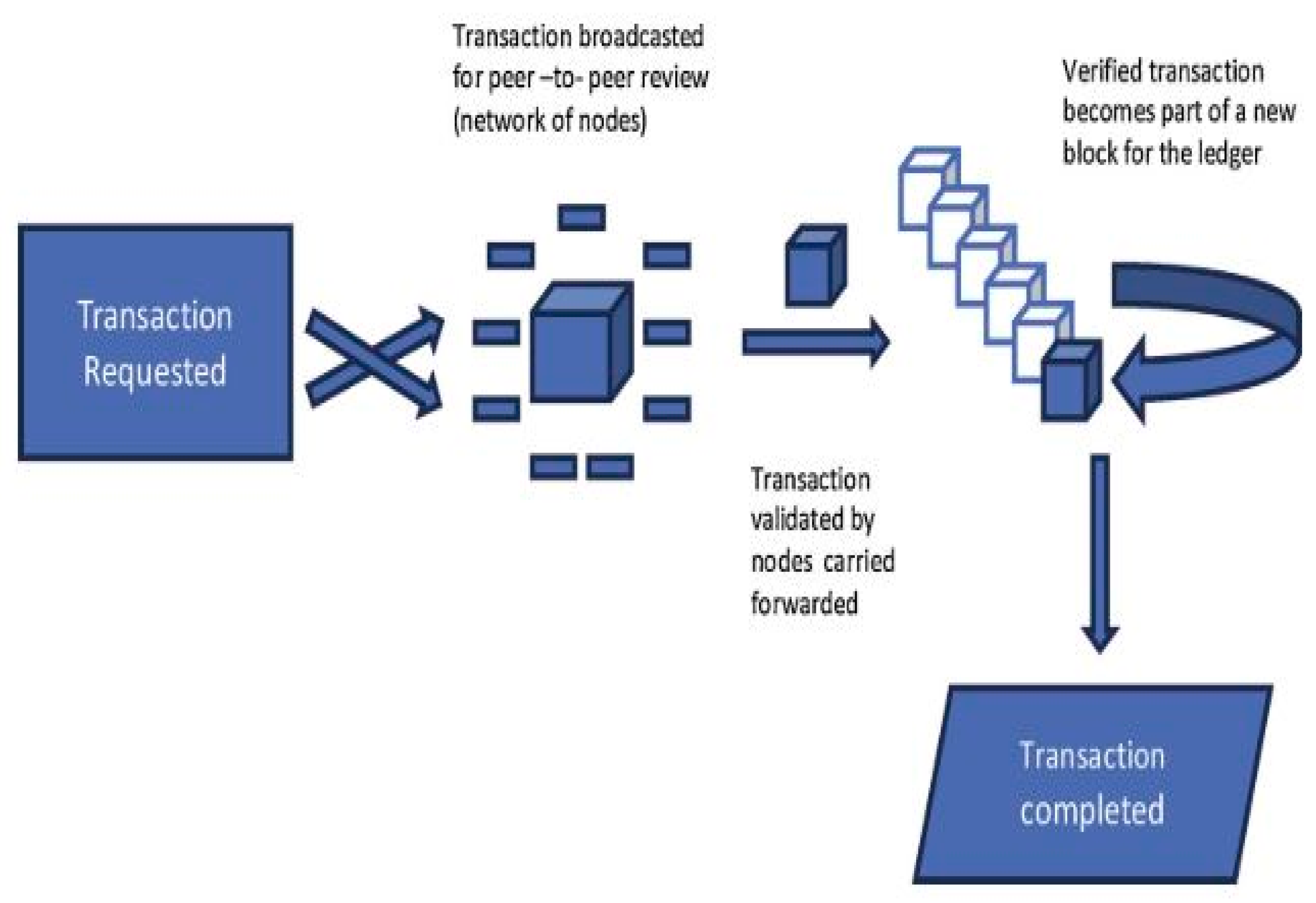
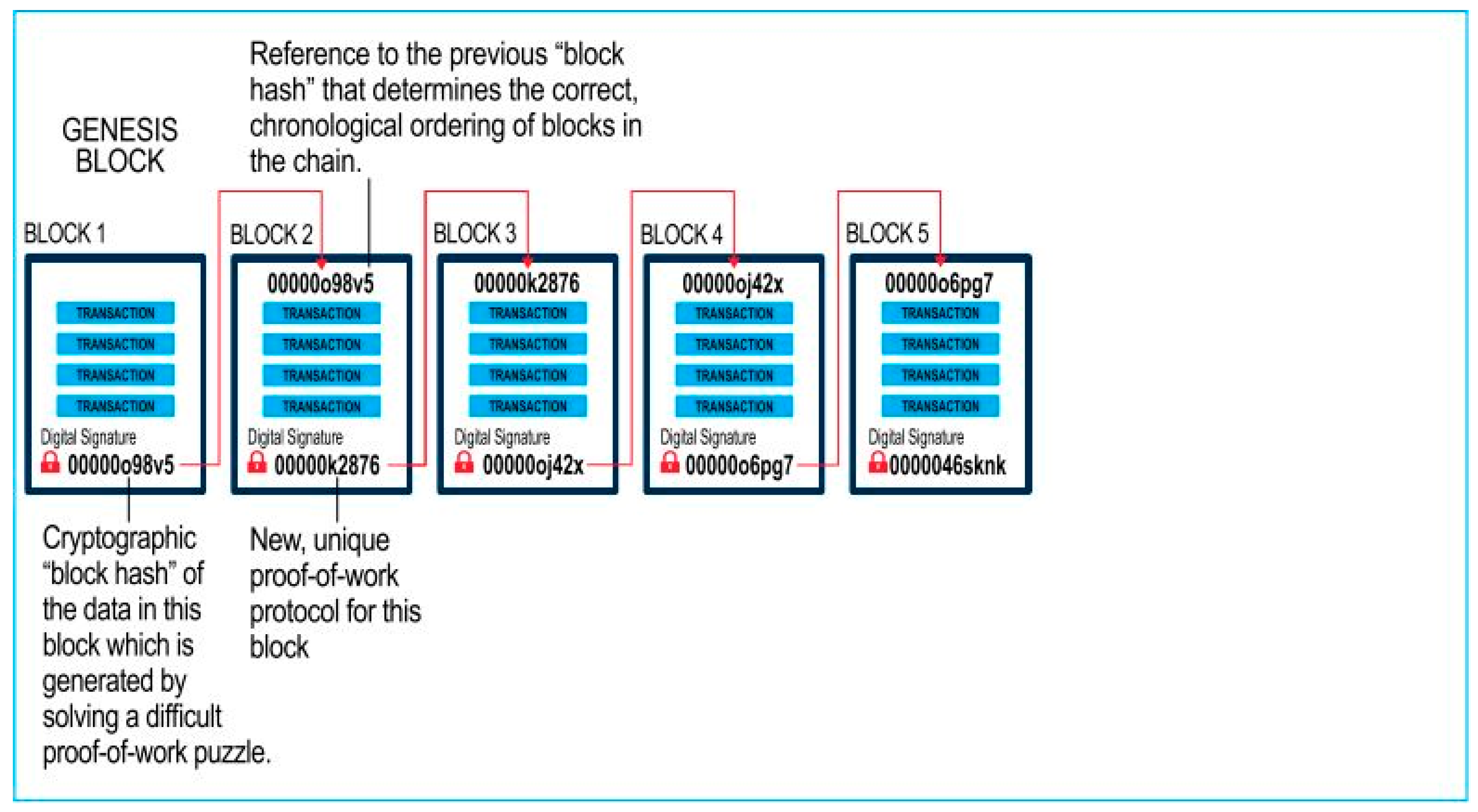
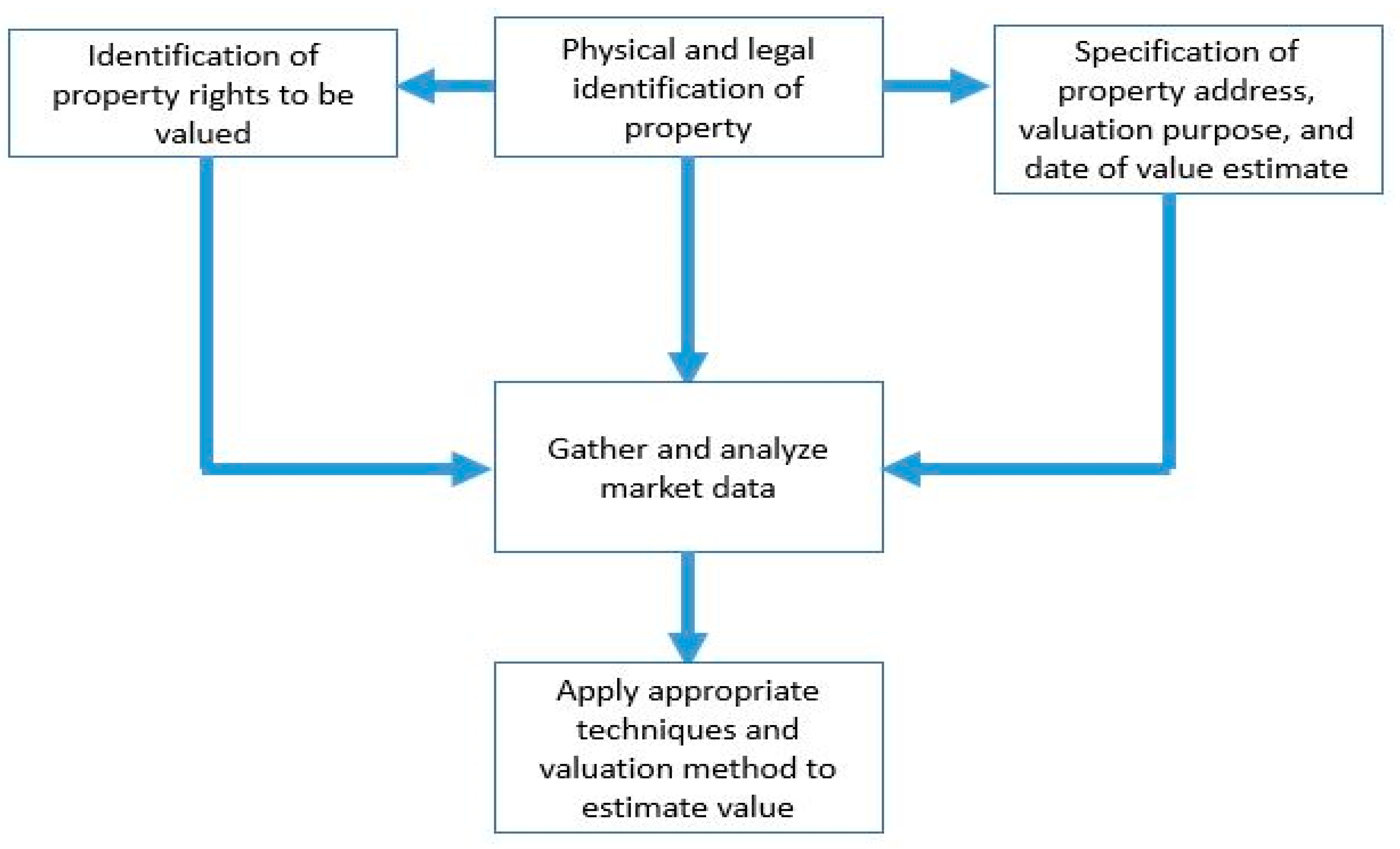
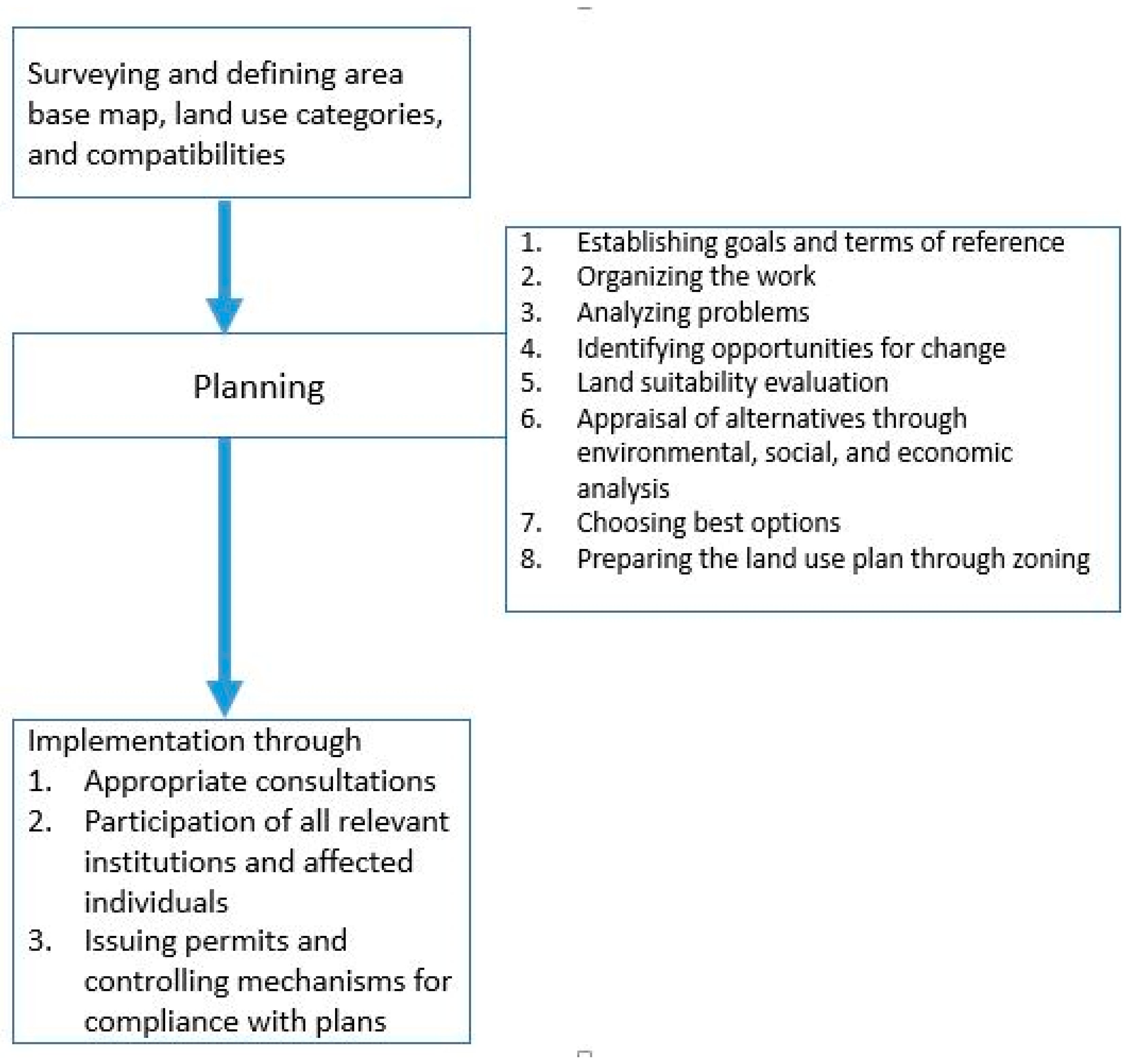
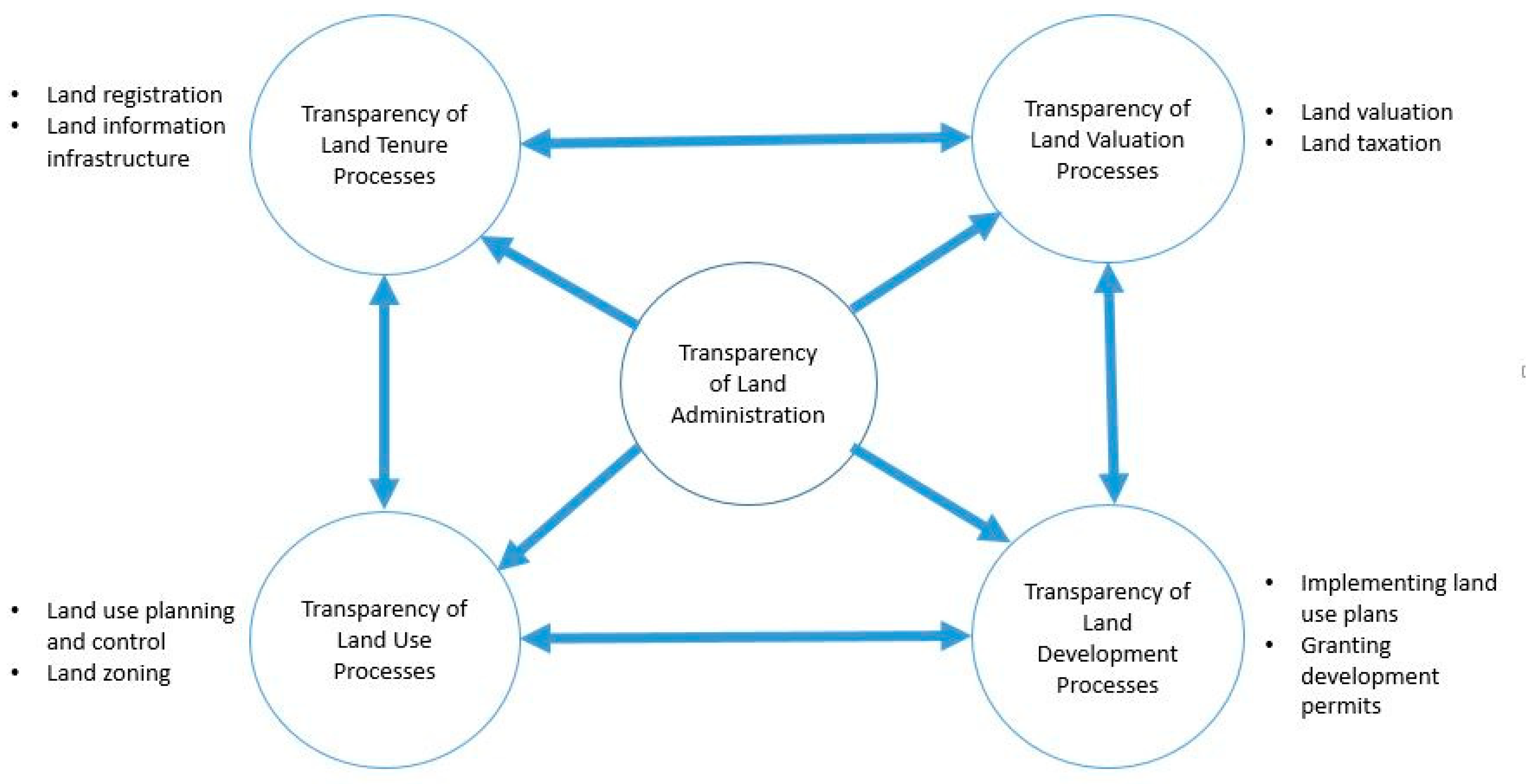
| Steps | Activities | Output | |
|---|---|---|---|
| 1 | Setting study boundaries |
|
|
| 2 | Literature identification:
|
|
|
| 3 | Initial literature review | Titles and abstract reading. |
|
| 4 | Detailed integrative review:
|
|
|
| 5 | Topic reconceptualization |
|
|
| 6 | Conclusion and recommendations |
|
|
| Potential Benefits of Blockchain | Elements that Make It Possible | References |
|---|---|---|
| Transparency | Decentralization of transactions across all nodes (stakeholders), possibility for evaluating the authenticity of the transaction by all stakeholders, and the access to all transactions and their historical records by all stakeholders. | [10,20,23,28,29] |
| Eliminating fraud and double sales | Decentralization—once a transaction has been completed, all stakeholders have copies and any further action on the transaction is known to the stakeholders. A second attempt to resell the land will be known to all stakeholders and therefore the transaction will not be validated since it has already been sold to another person. | [1,10,11,17] |
| Enhancing trust | Immutability and consensus mechanism—immutability of blockchain coupled with the consensus mechanism by majority stakeholders helps prevent manipulation of land data, as well as misrepresentation of land data in the system. | [1,20,23,26,44] |
| Establish clear ownership | Hashing—the existence and access to the historical facts on the transaction made possible by hashing allows ease in establishing the ownership status as well as all encumbrances. | [17] |
| Eliminating corruption | Smart contracts—land transactions based on and carried out using smart contracts helps to eliminate all forms of corrupt deals since all the procedures involved in the transaction are clear and can be carried out without human intervention thus leaving no room for corruption. | [20] |
| Eliminates manipulation | Decentralization and immutability—due to the distributed copies of transactions available to all nodes; and the difficulty to change blockchain data, any purported unauthorized changes or manipulation will be detected by all the stakeholders and will accordingly be declined or denied. | [10,23] |
| Easy information access | Decentralization—information stored is available to all the nodes at all times. This enhances the ease of access to land transaction information as there are no intermediaries. | [20,23,44] |
| Data quality, accuracy and integrity | Consensus mechanism—the verification and validation process inherent to the system ensures that the information accepted on the blockchain corresponds with reality on the ground. Any inconsistencies, and inaccuracies will lead to the rejection of the transaction. | [23] |
| Enhances high participation by all stakeholders | Decentralization—stakeholders become involved in the transaction at every stage due to the decentralized distribution across all the nodes. This allows all stakeholders to know about the transaction and to partake in it through the consensus mechanism. | [1,23,26,45] |
| Reduced human error possibilities | Smart contracts for land transactions help eliminate human involvement as all required actions necessary for carrying out transactions have been pre-programmed. Once a step is completed, the transaction moves to the next step without human actions until it is completed. | [10] |
| Security and resilience | Decentralization and distribution—due to the decentralized and distributed functionality, data are stored in multiple databases of different stakeholders which are tamper proof, immutable and encrypted. It is thus difficult to hack all the different databases at the same time. | [11,15,24] |
| Blockchain Architectural Categorizations | ||||
|---|---|---|---|---|
| Public Blockchain | Private Blockchain | |||
| Permissionless | Permissioned | Permissionless | Permissioned | |
| Participants | Anonymous | Identified | Identified | Identified |
| Data accessibility | Anyone | Anyone | Authorized participants | Authorized participants |
| Initiating transactions | Anyone | Authorized participants | Authorized participants | Network operator only |
| Participation in consensus mechanism | Anyone | Authorized participants | Authorized participants | Network operator only |
| Network types | Decentralized | Partly decentralized | Hybrid | Centralized |
Publisher’s Note: MDPI stays neutral with regard to jurisdictional claims in published maps and institutional affiliations. |
© 2020 by the authors. Licensee MDPI, Basel, Switzerland. This article is an open access article distributed under the terms and conditions of the Creative Commons Attribution (CC BY) license (http://creativecommons.org/licenses/by/4.0/).
Share and Cite
Ameyaw, P.D.; de Vries, W.T. Transparency of Land Administration and the Role of Blockchain Technology, a Four-Dimensional Framework Analysis from the Ghanaian Land Perspective. Land 2020, 9, 491. https://doi.org/10.3390/land9120491
Ameyaw PD, de Vries WT. Transparency of Land Administration and the Role of Blockchain Technology, a Four-Dimensional Framework Analysis from the Ghanaian Land Perspective. Land. 2020; 9(12):491. https://doi.org/10.3390/land9120491
Chicago/Turabian StyleAmeyaw, Prince Donkor, and Walter Timo de Vries. 2020. "Transparency of Land Administration and the Role of Blockchain Technology, a Four-Dimensional Framework Analysis from the Ghanaian Land Perspective" Land 9, no. 12: 491. https://doi.org/10.3390/land9120491
APA StyleAmeyaw, P. D., & de Vries, W. T. (2020). Transparency of Land Administration and the Role of Blockchain Technology, a Four-Dimensional Framework Analysis from the Ghanaian Land Perspective. Land, 9(12), 491. https://doi.org/10.3390/land9120491





